Everyone is asking…What is in good food? But maybe we should be asking what isn’t in good food.
Maybe you don’t know what you're eating. This is understandable since food manufacturers can now enhance flavor, color, and taste through chemical manipulation. They do this for popularity and profit.
What is in Good Food?
The question “what is in good food?” starts with awareness of what’s in mass-produced foods.
Just because certain foods are approved as safe, defended by the FDA, and promoted in a natural-looking, pretty package, does not mean it’s in our best interest or the health of our families.
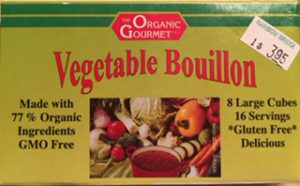 And don’t make the mistake of thinking that everything sold in a health food store is healthy. (like me!)
And don’t make the mistake of thinking that everything sold in a health food store is healthy. (like me!)
Recently I picked this up at my local health food store. It wasn't until I got home I noticed the 2nd ingredient is “yeast extract”…which is another name for MSG.
Who Owns What?
The Top 100 Food Processors
The chart below shows the top 100 food processors in North America. This is the industry structure for organic food and non-organic foods. The yellow circles are the food processors; the brown is their organic brands and acquisitions. The numbers refer to rank in North America according to food processing.
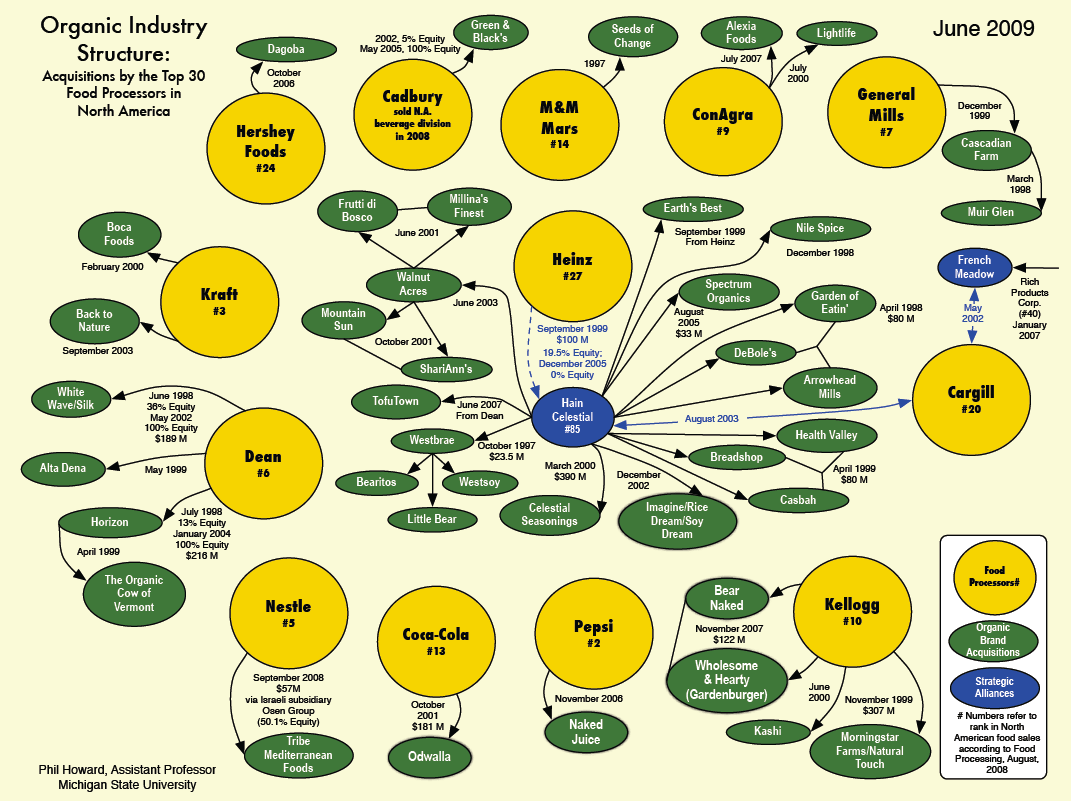
Giant food corporations have come to dominate the organic market, and there are additives in organic products you're buying, so make sure to read labels.
So let’s get right into it.
What Is In Good Food?
Insist all your food be organic and grown locally if possible. Did you know food grown closer to home (within 100 miles) is best because it's not shipped, boxed or trucked? (Which is healthier for the planet too).
But that's not all; good food is plentiful with prana (vitality, aliveness, life-force). Foods with abundant prana are organic, fresh, pure, vibrant and whole (not processed or mass-produced).
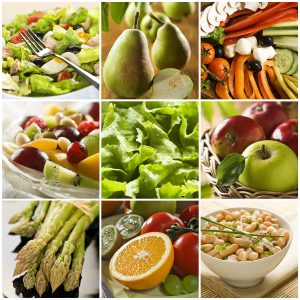
Good food heals.
Most Fresh Fruits & Vegetables
Apples – Prevents constipation, protects the heart, improves lung capacity
Apricots – Control blood pressure, good for eyes, protects against Alzheimer’s, slows the aging process
Avocados – Nourishes the liver, lungs, and skin. Helps build blood and muscles, controls blood pressure, lowers cholesterol.
Alfalfa sprouts – Cleanse blood and lymphatics and helps reduce fat and tumors. Good for acne, boils, arthritis, obesity, edema and tumors.
Artichokes – Cleanses the liver and blood, aids digestion, protects your heart.
Asparagus – Good for gout and arthritis.
Bananas – Protects your heart, quiets a cough, good for diarrhea, controls blood pressure.
Beets – Protects against cancer, strengthens bones, protects the heart, promotes menstruation, blood cleaner.
Bean Sprouts – Cleanses the liver and bile, good for alcoholism and hyperacidity.
Blueberries – Protects heart, stabilizes blood sugar, boosts memory, prevent constipation.
Broccoli – Strengthens bones, good for eyes, protects against cancer, cleanses the liver, controls blood pressure.
Cabbage – Prevents constipation, promotes weight loss, cleanses blood and liver, aids hemorrhoids.
Cantaloupe – Lowers cholesterol, supports the immune system, strengthens eyesight.
Carrots – Builds blood, brightens the eyes, good for chronic hepatitis, promotes weight loss, protects the heart.
Cauliflower – Fights breast and prostate cancer, good for bruises.
Cherries – Blood cleanser, tonic to the heart, aids insomnia, slowing the aging process.
Chili Peppers – Promotes digestion, clears sinuses, fights cancer, boosts the immune system.
Corn – Good for jaundice, hepatitis, gall stones, kidney stones, urinary tract infections.
Cucumbers – Dispels phlegm and heat from lungs, reduces inflammation.
Cilantro – Cleanses the blood and bile, good for urinary tract infections.
Figs – Promotes weight loss, helps with strokes, lowers cholesterol, combats cancer, controls blood pressure.
Grapefruit – Protects against heart attacks, promotes weight loss, prevents strokes, lowers cholesterol.
Grapes – Helps with kidney stones, fights cancer, enhances blood flow, protects the heart.
Lettuce – Calming and cleansing to the mind and emotions, cleanses blood and lymph.
Okra – Good for burning urination, diarrhea.
Onions – Good for colds and flu, general debility.
Radish – Expectorant and Anti-cough, aids in digestion of heavy food.
Seaweed – Good source of minerals, strengthens plasma, relieves congestion, good for thyroid.
Spinach – Good for fever and cough, cleanses the blood.
Squash – Good for a dry cough and laryngitis.
Tomatoes – Promotes circulation, builds the blood, prevents cholesterol and hypertension.
Turnips – Cleanse the blood and lymphatics.
Freshly prepared grains – Nutritive (builds tissues of the body), gives bulk to the stool.
Beans and lentils – Contain large amounts of protein and gives energy for physical work.
Fresh yogurt – Aids digestion, replenishes the positive flora in the gut, can be good for diarrhea.
Ghee – Improves intelligence, increases the power of vision and improve the voice.
Coconut Oil – Proven Alzheimer’s treatment, improves memory, prevents heart disease and high blood pressure, protects the liver, reduces inflammation and arthritis.
Honey – Helps with immune function (not good to bake or cook with, however. If you heat it over 180 degrees it becomes toxic).
Nuts and seeds Strengthening and rejuvenating. Good source of protein and fat from vegetable sources. Build the blood and muscles. Strengthen memory and creativity.
Lemon & Limes – Aids digestion, stimulates the flow of bile and helps dissolve gallstones.
Garlic – Highly nutritious and can combat a common cold by boosting the immune system.
Eggs – The whites are a good source of selenium, vitamin D, B6, and minerals such as zinc, iron, and copper.
Vinegar – Good digestive and circulatory stimulant.
What is in Bad Food
Bad food is any food that contains chemicals and additives that are known to harm either the human body or laboratory animals. The bottom line is, if they harm animals, they can harm you too.
Most of the ingredients you should avoid fall into one of three areas: food additives, artificial sweeteners, and artificial colors. Most importantly, experts agree that you're smart to avoid as many chemicals in your foods as possible.
As you may already know, shopping mostly the produce, dairy and meat sections of your grocery store, you can avoid many of the harmful food additives listed below.
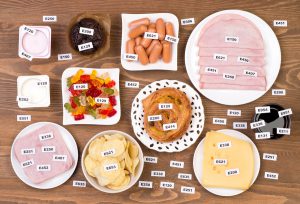
Trans Fat or trans-unsaturated fatty acids – Packaged in processed baked goods & fast food. Associated with coronary heart disease.
High Fructose Corn Syrup – Sweetener linked to obesity and diabetes.
Azodicarbonamide – Used in buns and bagels. Can cause asthma.
MSG, Monosodium glutamate – Flavor enhancer known to be a carcinogen, endocrine disrupter, and killer of brain cells, kidney problems, neurological disorders like Alzheimer’s, Parkinson’s and Lou Gehrig’s disease.
Yeast Extract – Another name for MSG
Artificial Sweeteners (saccharin, neotame, acesulfame potassium, aspartame, sucralose) Known carcinogen, possible cause of brain tumors, birth defects, epilepsy, Parkinson’s disease, Fibromyalgia, and Diabetes
Sodium – Increases blood pressure, which can lead to heart disease
Aluminum – A preservative suspected of causing breast and prostate cancer, causes osteoporosis, robs body of magnesium, calcium, and iron, causes oxidative damage to cells
Cellulose – Cellulose is basically sawdust. It’s mainly in processed low-carb foods. Could cause cancer in high quantities.
Enriched Flour – Is flour with specific nutrients (iron, B vitamins (folic acid, riboflavin, niacin, and thiamine) added back in that were lost while being prepared. These things added back to the flour are not a good thing because the body cannot utilize these fake nutrients. The body just reacts the same as if you were eating sugar, so it makes you fat.
Disodium Guanylate – Flavor enhancer (MSG) Found in instant noodles, potato chips and other snacks, cured meats, and packaged soup.
Disodium inosinate – Flavor enhancer (MSG) Found in instant noodles, potato chips and a variety of other snacks.
Butane – A known carcinogen in chicken nuggets to keep them fresh
BHA/BHT – A known carcinogen and fat preservative to extend shelf life.
Olestra – Used in snack foods in place of natural fats. Causes digestive problems and not healthy for the heart.
Chlorine dioxide – Used in bleaching flour. May cause hyperactivity in kids and tumors.
Polysorbate 60 – A thickening agent that causes cancer in lab animals.
Brominated vegetable oil – Keeps flavor oils in soft drinks suspended. Bromate is a toxin and can cause organ damage and birth defects.
Carrageenan – Thickening agent used in processed foods that cause users and cancer
Recombinant Bovine Growth Hormone – Genetically engineered version of natural growth hormone in cows to boost their milk production known to cause cancer.
Magnesium sulfate – Used in tofu and can cause cancer in lab animals.
Refined Vegetable oil – Includes soybean oil, corn oil, safflower oil, canola oil, and peanut oil. High in omega 6 fats, which are thought to cause heart disease and cancer.
Artificial Food colorings – Gives food a more attractive appearance but can cause health issues like asthma and hyperactivity in kids.
The Conclusion of What is in Good Food
Know what you’re eating, and how to read labels. Avoid fast food, processed food (anything in a package), sodas and sugary drinks and juices. Eat more fruits, vegetables and grains and hormone free meats. If you genuinely want to learn about what's in good food, take the next step with Todd Caldecott's Holistic Nutrition.
The program is also packed with reveals, tips, and tricks that can clear all your nutrition-related confusion. I just finished this course myself, and you can read my review of Holistic Nutrition here.
And, please don't hesitate to leave me a comment or question in the are below. I'm here to help you be the healthiest version of yourself possible. I'll get back to you within “hours” most of the time.
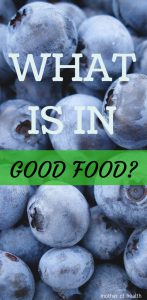

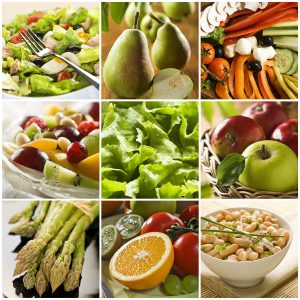


Jackie, Great article and this is a subject near and dear to my heart.
My goal is to live as long as possible without disease, of course to me that means what I put into my body.
I’m a card carrying “Nutritarian” which means that I eat the most nutrient dense food per calorie.
A simple rule that I follow is, “If it’s a plant Eat It. If it was made in a plant Don’t!”
Keep up the great work, I will be back.
Phil
Thanks Phil… I love the quote!
Hello Jackie! I am what your would call a health freak. therefore, I know lots about healthy food. On the contrary, I am not very aware of what’s in bad food. There’s so many hard to pronounce names and such which makes it complicated for me to understand. I’ve always wanted to brush up on these to be more aware. Thanks to your list, I now have a place to go for reference of these ingredients.
thanks for stopping by and happy to help you!
Thank you for the great information here! It is crazy what can be marketed as ‘natural’ or ‘healthy’ these days. I was reading an article in the WSJ that the FDA is going to be changing the nutrition fact labels and their criteria for healthy foods. In the current state a pop tart can be marketed as healthy! One of my friends who is very much into fitness says the key is to look at the ingredients. If it has more than 4 ingredients it may be highly processed and you should move on.
Good advice! and thanks for commenting! 🙂
This is probably one of the most important articles to read for anyone. What goes into our bodies directly impacts our health, so much so it pretty much dictates our health.
I used to be the same way too, thinking that as long as we’re shopping in a health food store that everything is okay to consume. Glad I wasn’t the only one (or not).
There really is no shortage if junky food with toxic ingredients. It seems the underlying principle is if we can’t find it in nature, it most likely isn’t safe to consume.
Amen! If it’s not natural, it’s not good. Thanks for commenting, Wing!
What a great list to pin to the fridge for reference! There are so many sneaky ingredients in foods that are deteriorating our health, and this is a great article to help you fight for your and your family’s health. I never knew yeast extract is another name for MSG! We know to avoid MSG, but these manufacturers are getting ridiculous with how they are naming and using these ingredients. Thank you for the information!
Thanks for commenting Martina. xo
You have a lovely site 🙂 I am interested in your advice to “insist on organic” produce. This is a pretty tall order, given the price or organic produce. My partner and I are health conscious and eat mainly unprocessed foods but buying organic would be very expensive, even for just the two of us. How important is it to eat organic and if we can’t eat everything organic are there some items that are more important to eat organically than others?
Thanks
Deb
Hi Deb! I know the choices we’re forced to make about food is complex and challenging… For me, the decision to favor pesticide-free produce is important. I buy most of our produce at the local farmer’s market so that it’s grown within 100 miles. If it’s out-of-reach for you, just follow the Dirty Dozen guide:
The Dirty Dozen (Always Buy Organic)
Apples
Celery
Sweet bell peppers
Peaches
Strawberries
Nectarines – imported
Grapes
Spinach
Lettuce
Cucumbers
Blueberries – domestic
Potatoes
+ PLUS
Leafy greens
Green Beans
The Clean 15 (OK to Buy Conventional)
Onions
Sweet Corn
Pineapples
Avocado
Cabbage
Sweet peas
Asparagus
Mangoes
Eggplant
Kiwi
Cantaloupe – domestic
Sweet potatoes
Grapefruit
Watermelon
Mushrooms